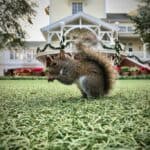Raccoons are naturally curious and agile creatures with a knack for scaling surfaces. If you’re hearing thumping noises on your roof at night, chances are that a raccoon is a culprit.
In this blog, we’ll explore the causes and consequences of raccoons on roofs and how to keep them away from your home.
We’ll also discuss the signs of raccoons on the top and the damage they can cause.
Finally, we’ll look at tips on safely removing them from your roof and answer whether raccoons sleep on roofs.
So, let’s dive in and learn more about these furry visitors!
The Natural Instincts of Raccoons
Table of Contents

As a homeowner, it is essential to understand the instincts of raccoons. Climbing is one of the most common instincts of raccoons, and they are well-equipped for it.
With strong hands and limbs designed for scrambling up various surfaces, it makes sense why raccoons often find themselves on your roof.
They may be attracted to the shingles because they provide an excellent surface to scratch when searching for food or escaping danger.
While scientists agree that raccoons are naturally well suited to urban life, understanding their natural behavior can help you determine how to best deter them from going on your roof.
Reasons Why Raccoons Go on Roofs
You may be wondering why raccoons are so often found on your roof. The truth is, they have several reasons.
One of the primary reasons is that they are looking for a safe place to rest and hide.
Climbing is one of their instincts, so they can quickly scramble up various surfaces with their powerful paws and limbs.
Roof entry points include holes such as uncapped chimneys, vents, and other openings.
Raccoons go on roofs for multiple reasons, and if you notice them on yours, it is likely because they have found a haven.
How to Deter Raccoons from Going on Your Roof
Firstly, try using strong-smelling products such as vinegar or ammonia around the perimeter of your roof and the bases of any trees on your property.
Remove old branches and seal any potential entry points with steel mesh. Consider installing a protective collar on your downspouts to prevent raccoons from using them as ladders to access difficult areas.
Signs of Raccoons on Your Roof
One of the most telling signs is the presence of dark, tubular droppings and a pungent smell in your attic.
To confirm your suspicions, paying close attention to when raccoons are most active at night is essential.
You likely have a raccoon problem if you notice any strange noises or movement on your rooftop during this time; you likely have a raccoon problem.
The Damage Raccoons Can Cause to Your Roof
They are known to rip shingles off or tear holes in the ceiling in search of shelter, leading to costly repairs.
Once inside, they can contaminate your home with feces and urine while destroying insulation.
If you spot them on your roof, it is vital to remove them safely and securely immediately.
The Noise Made By Raccoon on Your Roof
Raccoons are the largest animals you are likely to find in urban areas, and their size and weight can create a variety of noises. From scratching and thumping to shuffling and stomping, raccoons can make a racket on your roof.
Preventing Raccoons From Entering Your Home Through the Roof
- To begin with, trim any limbs on trees that give access to your roof.
- Clean up any roofing and attic clutter to remove potential shelter spots for raccoons.
- Inspect the outside of your home and repair any damage and weakness in the roof or soffit, as these provide entry points for raccoons.
- Consider installing a barrier such as flashing or mesh around your roof to make it harder for raccoons to access.
Tips for Safely Removing Raccoons From Your Roof
To do it safely, always wear protective clothing such as long sleeves, pants, and gloves when approaching the raccoons.
It is also essential to keep an eye out for any babies and be sure not to separate them from their mothers.
The safest way to remove raccoons is by setting up a one-way door that allows them to exit but not re-enter your home.
Consult a professional wildlife control specialist if you need help installing the door.
Once the raccoons have left, close off any access points they may have used to get onto the roof and secure them with solid mesh or other materials.
Do raccoons sleep on roofs?
Yes, they do. Raccoons are nocturnal creatures, meaning they are most active at night. This is why they often seek out roofs as safe places to sleep while the sun is down.
Raccoons are excellent climbers and can easily climb up onto roofs to sleep. They may also use the roof as a shelter during the day, especially when it rains or boils outside.
When raccoons sleep on your roof, you may hear them moving around, as they do not stay in one place long.








